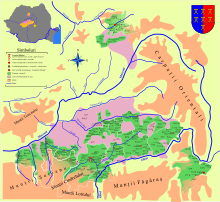Nösnerland

The Nösnerland (![]() listen (help·info); Romanian: Țara Năsăudului; Hungarian: Naszód vidéke) is an historic region of northeastern Transylvania in present-day Romania centered between the Bistriţa and Mureş rivers. In today's administrative boundaries, it is located in southern Bistrița-Năsăud County and north-central Mureș County.
listen (help·info); Romanian: Țara Năsăudului; Hungarian: Naszód vidéke) is an historic region of northeastern Transylvania in present-day Romania centered between the Bistriţa and Mureş rivers. In today's administrative boundaries, it is located in southern Bistrița-Năsăud County and north-central Mureș County.
Beginning in the 12th century and increasingly in the 13th-14th centuries, Hungarian kings invited German colonists to settle in the eastern lands of the Kingdom of Hungary; these German settlers became known as the Transylvanian Saxons. The Saxons in the southeast settled in the Burzenland, while the settlers in the northeast established towns along the Bistriţa and Mureş rivers beginning in the early 13th century. As the latter settlers' first major town in the area was Nösen on the Bistriţa in 1206, the surrounding area became known as the Nösnerland. The largest cities of this region were Nösen, later known as Bistriţa, in the north and Reghin in the south.
After Romania signed a truce with the Soviet Union during World War II, the evacuation of the German population of northeastern Transylvania was ordered by the German military in 1944. After the fall of the Communist regime of Romania in 1989, additional Transylvanian Germans have emigrated from their homeland to Germany.
Towns and villages
In each case, the modern Romanian name is given first, followed by the historic German and Hungarian names.
- Albeştii Bistriţei (Weißkirch bei Bistritz, Kisfehéregyház)
- Arcalia (Kallesdorf, Árokalja)
- Batoș (Botsch, Bátos)
- Bistriţa (Nösen / Bistritz, Beszterce)
- Chiraleş (Kyrieleis, Kerlés)
- Corvineşti (Niederneudorf, Kékesújfalu)
- Cuşma (Auen / Kuschma, Kusma)
- Dedrad (Deutsch-Zepling, Dedrád)
- Dipşa (Dürrbach, Dipse)
- Domneşti (Attelsdorf / Billak, Bilak)
- Dorolea (Kleinbistritz, Aszubeszterce)
- Dumitra (Mettersdorf, Szentdemeter)
- Dumitrița (Waltersdorf, Kisdemeter)
- Ghinda (Windau, Vinda)
- Herina (Mönchsdorf, Harina)
- Ideciu de Jos (Niedereidisch, Alsóidecs)
- Ideciu de Sus (Obereidisch, Felsőidecs)
- Jelna (Senndorf, Kiszsolna)
- Lechinţa (Lechnitz, Szászlekence)
- Livezile (Jaad, Jád)
- Logig (Ludwigsdorf, Ludvég)
- Monariu (Minarken, Malomárka)
- Moruţ (Moritzdorf, Aranyosmóric)
- Năsăud (Nassod / Nußdorf, Naszód)
- Orheiu Bistriţei (Burghalle, Óvárhely)
- Petelea (Birk, Petele)
- Petriș (Petersdorf bei Bistritz, Petres)
- Posmuş (Paßbusch, Paszmos)
- Reghin (Sächsisch-Regen, Szászrégen)
- Sângeorzu Nou (Sankt Georgen bei Lechnitz, Szászszentgyörgy)
- Sâniacob (Jakobsdorf bei Bitritz, Szászszentjakab)
- Satu Nou (Oberneudorf, Felsőszászújfalu)
- Sigmir (Schönbirk, Szépnyír)
- Slătiniţa (Pintak, Pinták)
- Şieu (Groß-Schogen, Nagysajó)
- Șieu-Măgheruș (Ungersdorf, Sajómagyarós)
- Tărpiu (Treppen, Szásztörpény)
- Teaca (Tekendorf, Teke)
- Tonciu (Tatsch, Tacs)
- Uila (Weilau, Vajola)
- Unirea (Wallendorf, Aldorf)
- Vermeş (Wermesch, Vermes)
- Viile Tecii (Großeidau, Kolozsnagyida)
- Viişoara (Heidendorf, Besenyő)
See also
External links
- Map showing German settlements in Transylvania
- Umriss Nösnerland und Reener Ländchen (German)
- Holzkirchen im Nösnerland (German)